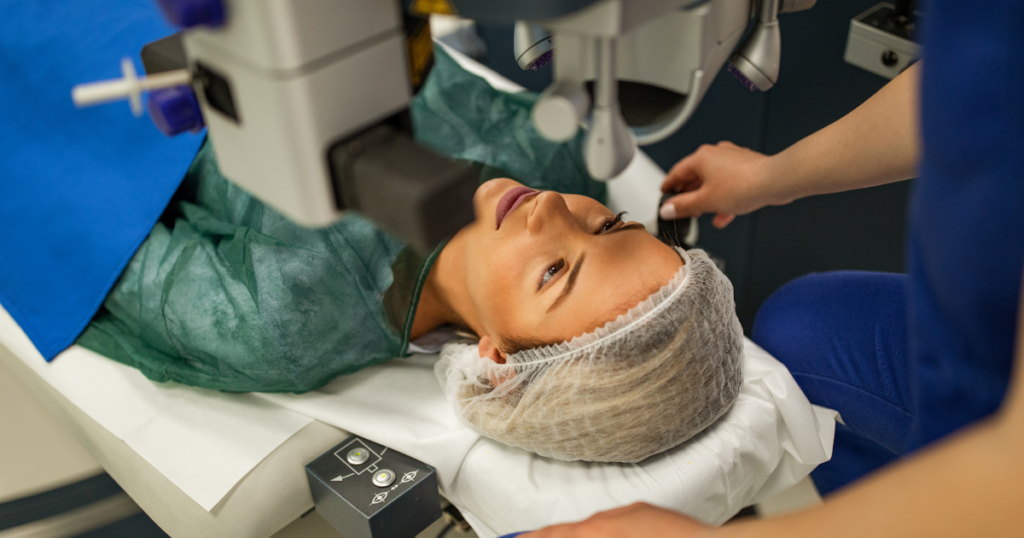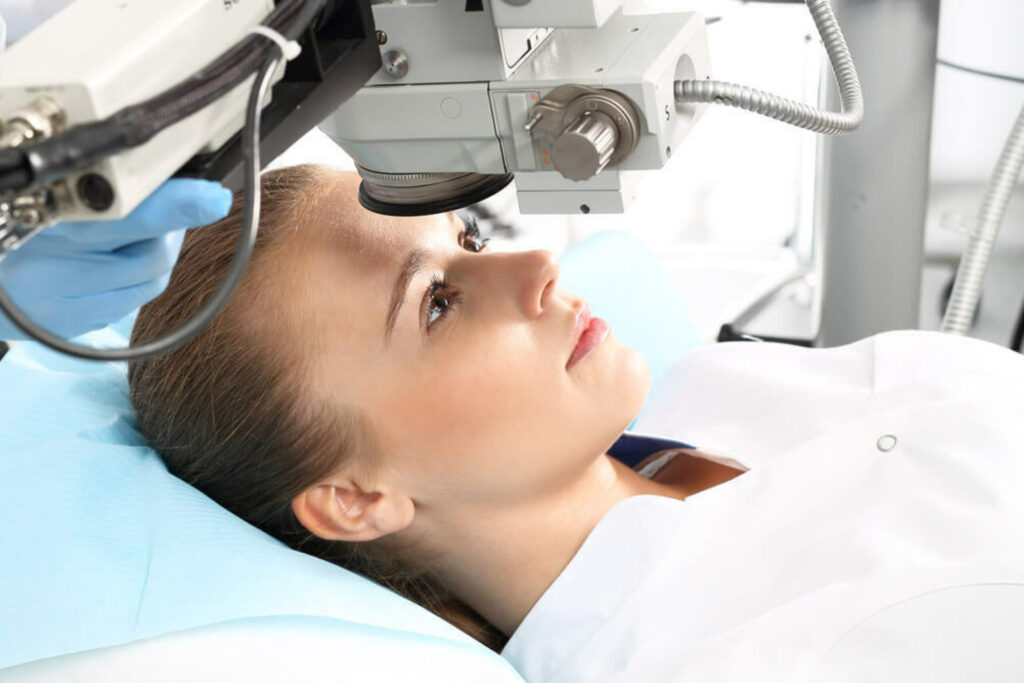Laser eye surgery is a procedure that has revolutionized vision correction. With its precision and effectiveness, it has become one of the most popular surgical procedures in the world. This ultimate guide will take you through the techniques, benefits, and recovery process of laser eye surgery, providing you with all the information you need to make an informed decision about this life-changing procedure.
Understanding Laser Eye Surgery
Before undergoing laser eye surgery, patients typically undergo a comprehensive eye examination to determine their candidacy for the procedure. Factors such as corneal thickness, pupil size, refractive error, and overall eye health are carefully evaluated to ensure the best possible outcomes.
What is Laser Eye Surgery?
Laser eye surgery, also known as refractive surgery, is a revolutionary procedure that has transformed the lives of millions of people worldwide. It utilizes cutting-edge laser technology to reshape the cornea, the transparent front surface of the eye. By precisely altering the cornea’s curvature, laser eye surgery corrects common refractive errors such as nearsightedness (myopia), farsightedness (hyperopia), and astigmatism, allowing individuals to reduce or eliminate their dependence on glasses or contact lenses.
The Science Behind the Procedure
The remarkable success of laser eye surgery can be attributed to the precise removal of microscopic amounts of tissue from the cornea. This reshaping process enables light to accurately focus on the retina, resulting in clearer and sharper vision. The key instrument used in laser eye surgery is the excimer laser, a sophisticated device that emits a cool ultraviolet light beam. This beam interacts with the corneal tissue, gently vaporizing it with unparalleled precision and safety.
During the procedure, the patient’s eye is held open with a specialized device, and anesthetic eye drops are used to ensure comfort throughout the surgery. The surgeon then guides the excimer laser over the cornea, sculpting it to the desired shape based on the patient’s unique prescription. The entire process is quick, typically lasting only a few minutes per eye, and patients often experience improved vision almost immediately after the surgery.

Types of Laser Eye Surgery
LASIK: The Most Common Procedure
LASIK (Laser-Assisted in Situ Keratomileusis) is the most commonly performed laser eye surgery procedure. It involves creating a thin flap on the cornea using a microkeratome or a femtosecond laser. The flap is then lifted, and the underlying corneal tissue is reshaped using the excimer laser. Finally, the flap is repositioned, creating a natural bandage that promotes healing and improves visual recovery.
One of the key advantages of LASIK is its rapid recovery time, with many patients experiencing improved vision within a day or two after the surgery. The procedure is known for its high success rate in correcting refractive errors such as nearsightedness, farsightedness, and astigmatism. LASIK has become a popular choice for individuals looking to reduce their dependence on glasses or contact lenses. Read more about farsightedness on https://www.nei.nih.gov/learn-about-eye-health/eye-conditions-and-diseases/farsightedness-hyperopia
PRK: An Alternative to LASIK
PRK (Photorefractive Keratectomy) is an alternative to LASIK, suitable for individuals with thin corneas or those involved in contact sports. In PRK, the protective outer layer of the cornea, called the epithelium, is completely removed to expose the underlying corneal tissue. The excimer laser then reshapes the cornea, and a contact lens is placed on the eye to facilitate healing during the initial recovery phase.
While PRK may have a slightly longer recovery period compared to LASIK, it can achieve similar visual outcomes in patients. This procedure is often recommended for individuals with corneal irregularities or those who may not be suitable candidates for LASIK due to certain eye conditions.
LASEK: Combining the Best of Both
LASEK (Laser-Assisted Subepithelial Keratectomy) combines the benefits of LASIK and PRK. In LASEK, a thin layer of corneal epithelium is gently lifted using a special solution. The excimer laser is then used to reshape the cornea, similar to LASIK. After the procedure, a soft contact lens is placed on the eye to protect the cornea during the healing process.
One of the advantages of LASEK is its ability to preserve more corneal tissue compared to LASIK, making it a suitable option for individuals with thinner corneas or those at higher risk of eye trauma. This procedure may be recommended for patients seeking a balance between the quick recovery of LASIK and the surface treatment of PRK.
The Benefits of Laser Eye Surgery
Improved Vision Quality
One of the primary benefits of laser eye surgery is the significant improvement in vision quality. Many individuals achieve 20/20 vision or better after the procedure, reducing or eliminating the need for glasses or contact lenses. The precise correction of refractive errors allows for crisp and clear vision in various lighting conditions.
Moreover, laser eye surgery can also correct astigmatism, a common condition that causes blurred vision. By reshaping the cornea with advanced laser technology, patients can experience a dramatic improvement in their overall visual acuity, leading to a more vibrant and detailed perception of the world around them.
Long-term Cost Benefits
While laser eye surgery is an investment upfront, it can result in long-term cost savings. Glasses and contact lenses require ongoing maintenance, regular replacements, and the associated costs. By eliminating or reducing the dependence on visual aids, laser eye surgery can lead to significant savings in the long run.
Additionally, the convenience of not having to purchase prescription eyewear or contact lens supplies regularly can free up financial resources for other important aspects of life, providing a sense of financial relief and independence for individuals who undergo the procedure.
Lifestyle Changes and Freedom
Laser eye surgery offers freedom and convenience that can greatly enhance your lifestyle. Say goodbye to the hassle of glasses fogging up in cold weather, or the discomfort of dry eyes caused by contact lenses. With improved vision, activities like swimming, sports, and traveling become more enjoyable and hassle-free.
Furthermore, the newfound visual clarity and independence from corrective eyewear can boost self-confidence and open up new opportunities for individuals in various aspects of their personal and professional lives. Whether it’s confidently navigating a presentation at work or simply enjoying a spontaneous road trip without the need to pack extra eyewear, laser eye surgery can truly revolutionize how you experience the world.
Preparing for Laser Eye Surgery
Initial Consultation and Eye Examination
Prior to undergoing laser eye surgery, you will have an initial consultation with an eye surgeon. During this visit, your eyes will be thoroughly examined to determine your suitability for the procedure. The surgeon will assess your eye health, corneal thickness, and refractive error to formulate a personalized treatment plan.
Additionally, the initial consultation is an opportunity for you to ask any questions you may have about the surgery. You can discuss potential risks, benefits, and expected outcomes with the surgeon to ensure you are well-informed and comfortable with the procedure. It is crucial to provide your surgeon with a comprehensive medical history, including any medications you are taking and any pre-existing eye conditions. To find more about potential risks click here.
What to Expect on the Day of Surgery
The day of surgery will begin with the application of numbing eye drops to ensure a comfortable experience. You will then be guided into the laser suite where you will lie down on a reclining chair. A special device called an eyelid speculum will be used to hold your eyelids open. While you may feel slight pressure during the procedure, it is generally painless.
Once you are positioned comfortably, the surgeon will use a laser to reshape your cornea, correcting your vision. The entire procedure typically takes around 15 minutes per eye. After the surgery, you may experience some mild discomfort or irritation, but this can be managed with prescribed eye drops and rest. It is important to follow post-operative care instructions provided by your surgeon to ensure a smooth recovery and optimal results.

The Laser Eye Surgery Procedure
Considering laser eye surgery? Let’s delve deeper into the step-by-step process to understand what happens during this life-changing procedure. Once you are comfortably positioned, the first step involves creating a flap on the cornea (in the case of LASIK or LASEK) or removing the epithelium (in the case of PRK). This initial stage is crucial as it allows the surgeon access to the underlying corneal tissue for reshaping.
Following the creation of the flap or removal of the epithelium, the excimer laser takes center stage. This highly precise laser will reshape your cornea according to the treatment plan meticulously crafted during your pre-operative consultation. The reshaping process is swift and efficient, typically lasting only a few minutes per eye. The advanced technology of the excimer laser ensures accuracy and optimal outcomes for your vision correction needs.
Duration and Pain Management
Laser eye surgery is renowned for its quick and efficient nature. The actual laser treatment itself lasts only a few seconds per eye, making it a convenient option for those with busy schedules. One of the most appealing aspects of laser eye surgery is its painless nature. The laser used in the procedure produces no heat, and the application of numbing eye drops ensures a comfortable experience throughout.
While the surgery is generally painless, some individuals may experience mild discomfort or a foreign body sensation in the immediate post-operative period. This discomfort is typically manageable with prescribed eye drops and over-the-counter pain medications, providing relief as your eyes heal and adjust to their new state. The recovery process from laser eye surgery is often rapid, with many patients noticing improved vision within days of the procedure.
Your eye surgeon will equip you with detailed post-operative instructions to facilitate a smooth recovery process. Additionally, they will schedule follow-up appointments to monitor your progress and address any concerns that may arise. Laser eye surgery has the potential to transform your life by enhancing your vision and reducing your dependence on corrective eyewear. To explore whether you are a suitable candidate for this life-changing procedure, consult with a qualified eye surgeon who can guide you through the process with expertise and care.
Other resources: Laser Eye Surgery Sydney Cutting-Edge Solutions for Vision Correction

